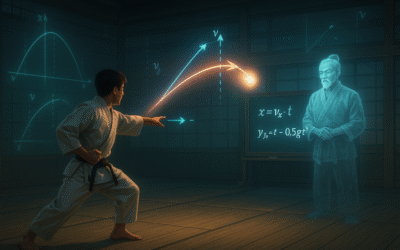🥋 Kinematics in One Dimension – White to Black Belt Mastery
“Motion is the story of position changing with time.”
White Belt Level – Key Concept
Kinematics is the study of motion without worrying about forces.
In one dimension, we only track how position (x), velocity (v), and acceleration (a) change over time.
In simple words: Kinematics tells us where, how fast, and how motion changes.
🎮 Explore: PhET Simulation – Moving Man
Core Principles
- Position (x): Where an object is located along a line.
- Displacement (Δx): Change in position (final – initial).
- Velocity (v): Rate of change of position (m/s).
- Acceleration (a): Rate of change of velocity (m/s²).
- Free fall: Vertical motion under gravity, with a = g = 9.81 m/s² downward (ignoring air resistance).
📖 Learn more: OpenStax University Physics, Ch. 2
Key Equations (SI Units)
- v = Δx / Δt
- a = Δv / Δt
- x = x₀ + v₀ t + ½ a t²
- v = v₀ + a t
- v² = v₀² + 2 a (x – x₀)
📄 Reference: OpenStax – Physics Formula Appendix
Common Mistakes and Pitfalls
- Mixing up displacement (Δx) with distance traveled.
- Forgetting acceleration direction (especially with free fall).
- Using the wrong equation for the situation (always check what information is given).
🔎 See also: HyperPhysics – Kinematics
Sensei’s Shortcuts
⏱️ Equation Picker Trick:
- If you know time → use v = v₀ + a t or x = x₀ + v₀ t + ½ a t².
- If you don’t know time → use v² = v₀² + 2 a (x – x₀).
Worked Example – Step by Step (White Belt)
Problem: A car starts from rest and accelerates at 2.00 m/s² for 5.00 s. How far does it travel?
Step 1. Formula:
x = x₀ + v₀ t + ½ a t²
Step 2. Substitution:
x = 0 + 0 × 5.00 + ½ × 2.00 × (5.00)²
Step 3. Solve:
x = 0.5 × 2.00 × 25.0 = 25.0 m
Step 4. Final Answer:
x = 25.0 m
Practice Drill (White Belt)
- A ball starts at rest and accelerates at 3.00 m/s² for 4.00 s. How far does it move?
Answer: 24.0 m - A runner moves at constant speed of 6.00 m/s for 10.0 s. How far do they travel?
Answer: 60.0 m
Yellow Belt Extension – Deeper Skills
Problem: A car is moving at 20.0 m/s and brakes with constant acceleration –4.00 m/s². How far does it travel before stopping?
Solution Outline:
- Use v² = v₀² + 2 a (x – x₀)
- Final velocity v = 0
- 0 = (20.0)² + 2 (–4.00)(Δx)
- Δx = 400 / 8 = 50.0 m
Final Answer: Δx = 50.0 m
🎮 Test this with PhET Moving Man.
📖 Extra reading: Khan Academy – 1D Motion
Black Belt Mastery – Exam Strategy and Challenge
Challenge Problem: A rock is thrown straight upward with velocity 15.0 m/s.
a) How high does it go?
b) How long is it in the air before returning to the ground?
Strategy Notes:
- At the top: v = 0.
- Use v² = v₀² + 2 a (x – x₀) for height.
- Use v = v₀ + a t for time up, then double for total time.
Solution:
a) v² = v₀² + 2 a Δx
0 = (15.0)² + 2 (–9.81)(Δx)
Δx = 225 / (2 × 9.81) = 11.5 m
b) Time up: v = v₀ + a t
0 = 15.0 – 9.81 t → t = 1.53 s
Total time = 2 × 1.53 = 3.06 s
Final Answers:
a) Max height = 11.5 m
b) Time of flight = 3.06 s
🚀 Related: NASA – Free Fall and Gravity
Sensei’s Final Words
Kinematics is your dojo warm-up. Master these equations, and you’ll predict motion before touching forces. Always ask: What do I know? Time, velocity, or distance? Then pick the right equation and strike.


0 Comments